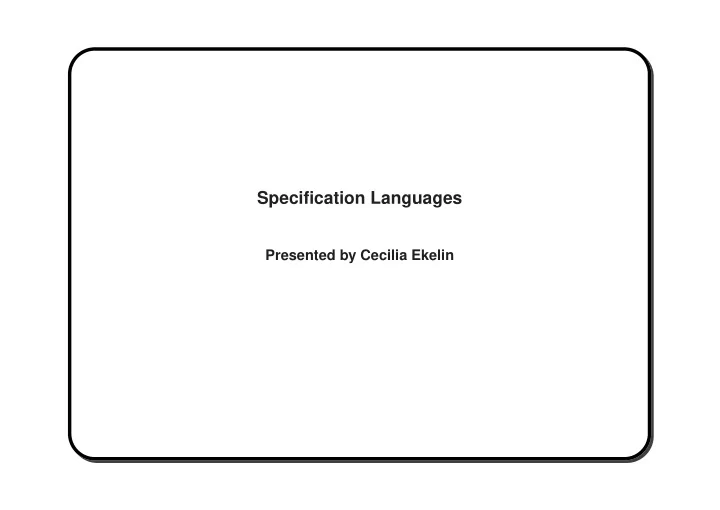

Specification Languages Presented by Cecilia Ekelin
Purpose of the language � To express the specification of the system to be designed � To enable formal reasoning about the design � To provide possibilities for tool support on modeling, validation and implementation
Implications on language design � A high-level approach necessary to cope with system complexity - Should be possible to express typical concepts � The language should be based on formal semantics (Models of Computation) - No assumptions about implementation � Formal syntax required as input to tools - Should be intuitive to the user
Concepts of embedded systems � Concurrency - Interleaved vs Parallel - Control vs Data oriented � Hierarchy - Behavioral vs Structural � Communication - Message passing vs Shared memory � Synchronization - Synchronous vs Asynchronous � Implementation - Software vs Hardware � Time ?
Models of computation � Synchronization (Communication) - Single vs Multi-thread � Concurrency (Functionality) - Data vs Control-driven Representations: language-oriented (graphs), architecture-oriented (FSM)
Languages VLSI System Design: � Hardware abstraction levels, timing and data flow computations � Hardware Description Languages (HDLs) � E.g., VHDL, HardwareC, SpecCharts, SpecC
Languages (continued) Protocol specification: � Formal description to enable verification � LOTOS - Based on process algebra and abstract data types - Specification is executable � SDL - Based on extended FSMs - Both graphical and textual modeling � ESTELLE - Pascal-like programming language - Implementation details necessary
Languages (continued) Reactive (real-time) system design: � Need to guarantee (timely) response to events � ESTEREL - Based on events - Synchronous time model � LUSTRE, SIGNAL - Based on programmable automaton - Simple time aspects in LUSTRE but more advanced in SIGNAL � Petri net tools - Based on Petri nets - Not always formally defined
Languages (continued) Programming languages: � Often lacking constructs for concurrency and timing � Extensions break the language standards � E.g., C, Ada, Java, Fortran
Languages (continued) Formal methods: � Offers high abstraction but perhaps not all necessary concepts � VDM, Z - Based on set theory and predicate logic - “Lack of tools” (www.ifad.dk) � B - Based on Abstract Machine Notation
Languages (continued) Structural Analysis: � Systematic approach for structuring code and data in software systems � “Divide and conquer” � E.g., OO, UML
Languages (continued) Continuous languages: � High-level modeling based on differential equations � Used for DSP , mechanical and hydraulic design � Large expressiveness makes verification and synthesis hard � E.g., Matlab, Matrixx, Mathematica
Case Study: SDL Hierarchy � System � Block � Process � Procedures
Case Study: SDL (continued) Communication & Concurrency � No global data � Asynchronous signals � Synchronous RPC:s � Channels interface blocks and processes � A signal is sent to an explicit process instances
Case Study: SDL (continued) Time � time and duration � A process may start timers � Timeouts are received as signals � Timing can be simulated before implementation
Case Study: SDL (continued) Implementation � Data is described using ADT or ASN.1 � Easily converted to other languages � Reuse possible
Tool support � Editor � Simulator � Proover � Debugger � Prototyper
Heterogeneous modeling � Different phases (specification, design, implementation) � Different subsystems (protocols, signal processing, control tasks) Multilanguage design: Select language for each component and perform integrated validation
Multilanguage validation � Independent approach - Individual validation � Integrated (compositional) approach - Translate each language into a general representation on which validation is performed - E.g., Polis environment which is based on Codesign FSM � Coordinated (cosimulation) approach - Validate each component separately but within a common framework
Cosimulation models � Data model - User-defined types ? � Timing model - No time (functional validation) - Time (granularity) � Synchronization (communication) model - Master-slave (direct connection) - Distributed (software “bus”) � Interfaces - In framework and implementation
Example - Automotive application Three levels: system, system architecture, cycle � System: Electronics (SDL) and Mechanics (Matlab) - Determines external specification � Architecture: Hardware (VHDL) and Software (C) - Validates partitioning and communication protocols � Cycle: Gates and Binary code - Verifies timing behavior Prototyping
Comments � “Performance” measures (development, usability, turn-around time, cost) � Generalization (tools, concepts)
Recommend
More recommend